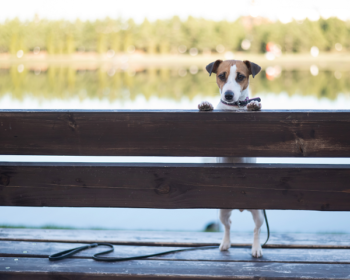Pet owners can do everything right to prevent their pet from becoming lost but, unfortunately, it still sometimes happens. When it does, time is of the essence, effective online and in-person communication is vital, and safety for you, your family, and the pet in question should be a top priority. So, what should you do if you lose your own pet or find someone else’s pet?
If you LOSE your pet:
Search your neighborhood right away! Start on foot while a friend or family member who knows your pet slowly drives around the neighborhood. Call your pet’s name in a happy tone, shake a bag of treats, or squeak their favorite toy. Ask your neighbors if they’ve seen your pet and if you may search their property. Cats and shy, small dogs are likely to find hiding places like bushes or under a car, deck, or patio furniture. Cats feel safer from vantage points, so look in trees, too. More outgoing dogs may find their way to their favorite park or find other dogs/people to follow and/or play with.
Contact local animal shelters & animal control. When people see or capture a stray pet, they often contact shelters and animal control agencies, so it’s likely one of these groups may already have your pet in custody, or at least have a report of when and where it was last seen. Many shelters have a holding period of about one week so it’s crucial to call daily and check if your pet is there. Don’t rely on the shelter to call you; they are usually extremely busy so it’s best if you check in with them regularly.
Search and post on social media. Social media outlets like Facebook have groups dedicated to reuniting lost pets with their owners and most cities/regions have their own dedicated pages. Try searching for something like “Lost Pets of MY CITY” and share a post about your pet. Include a high-quality, recent photo of your pet, any unique markings it has, and any cautions about your pet’s temperament (e.g., shy, might bite) and/or medical conditions (e.g., may be in pain due to missed medication).
Sometimes, people share photos and descriptions of lost pets they have seen in the area, so check back regularly to see if your pet has been posted. Adjust your phone and email notification settings to make sure you don’t miss anything.
When you do find your pet, update the social pages/groups you posted on to let everyone know the good news. It’s a courtesy to notify them so they stop searching AND people love to see the positive impact their community has! Click here to read a heartwarming story about a woman reunited with her cat three years after he went missing, thanks to social media.
Print and distribute flyers. Post flyers in your neighborhood and public places like grocery stores, veterinary offices, and traffic intersections. Describe your pet as you did on social media, include a high-quality photo, and provide your contact information. Use plastic coverings for flyers posted outdoors so they aren’t ruined by wind and rain.
Again, when you do find your pet, it’s courteous to remove your flyers so people don’t continue searching for your pet and to prevent them from becoming littered.
If you FIND a lost pet:
Safety is the top priority! It’s important to keep yourself, your family, your own pets, and the lost pet safe. If you aren’t familiar with the lost animal, use extreme caution. You don’t know the animal’s temperament or health status. Even an animal that seems friendly may try to bite or scratch, especially if it has suffered an injury (which isn’t always obvious), putting its subject at risk of injury, infection, and/or disease. Exposing your pets to a stray animal, healthy or not, will disrupt their environment, which can be very stressful.
Call the professionals. If you find a lost pet, contact your local animal control agency. They have experienced handlers and typically operate on a 24/7 basis. If the animal seems unwell or injured, the agency will likely seek veterinary care for it. They can also scan for a microchip and attempt to locate the pet’s owner if possible.
Check lost pet pages/groups on social media. As mentioned earlier, many people will post on social media in hopes of finding their lost pet. Simply sharing a brief description and location can be an enormous help to someone looking for their pet. Upload a photo of the animal as well, but only if you can safely capture one.
LifeLearn News
Note: This article, written by LifeLearn Animal Health (LifeLearn Inc.) is licensed to this practice for the personal use of our clients. Any copying, printing or further distribution is prohibited without the express written permission of Lifelearn. Please note that the news information presented here is NOT a substitute for a proper consultation and/or clinical examination of your pet by a veterinarian.


